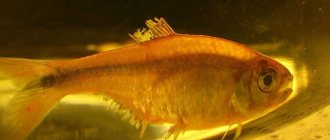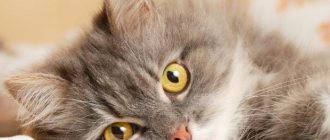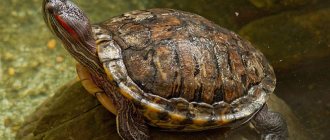Classification of diseases
Diseases of aquarium fish caused by pathogens:
- Infectious.
- Invasive.
Diseases that are not caused by pathogens:
- Physical etiology.
- Chemical etiology.
- Diseases as a result of improper feeding regimen and quality.
Roughly they can be divided into the following:
- Caused by pathogens:
- Bacteria;
- Fungi;
- The simplest;
- Coelenterates;
- Flatworms;
- Acanthocephals;
- Viruses;
- Crustaceans;
- filamentous helminths
- Not caused by pathogens:
- Chemical etiology (poisoning with toxic substances);
- Physical etiology (due to improper care of fish - poor quality of the aquatic environment, disturbed temperature conditions);
- The result of improper feeding (bloating, food poisoning).
Prevention of aquarium fish diseases:
Prevention of fish diseases is very important to prevent diseases that often arise as a result of violations of maintenance rules or the introduction of infections from the outside.
To keep the fish from getting sick, we recommend following the following rules:
- regularly and constantly carry out weekly cleaning of the aquarium in combination with replacing an average of 1/4 of the water volume, to prevent overcrowding of the aquarium;
- do not place objects (decor) in the aquarium that can cause poisoning or injury to aquarium fish;
— purchase only high-quality fish food and ensure its proper storage;
- be sure to follow the feeding schedule (1-2 times a day), do not leave the fish hungry and do not allow them to be overfed;
— maintain an optimal and constant temperature in the aquarium, recommended for specific types of fish, to exclude the possibility of sudden changes and hypothermia;
— ensure reliable transportation of fish;
— in winter, be sure to use a thermostat;
— quarantine newly purchased fish by placing them in a designated aquarium filled with water from an existing aquarium;
- aquarium equipment (nets, siphons, etc.) used by patients must be thoroughly disinfected (with potassium permanganate, rivanol, table salt, boiling) before using it for healthy fish;
— when treating fish with medications and chemicals, strictly adhere to the dosage to prevent poisoning.
Common diseases caused by chemical or physical factors:
Chlorine poisoning. When exposed to chlorinated water for a long time, islands of mucus appear on the fish’s body, the gills become lighter in color and are also covered with mucus. The fish has difficulty breathing and may attempt to jump out of the water.
Its death can occur very soon if it is not removed from the water disinfected with chlorine in time. It is important for novice aquarists to take note that when changing the water in the aquarium, it is necessary to check the tap water every time for the presence of
chlorine impurities. It is better to let the water sit for several days until the chlorine completely evaporates. If, nevertheless, the fish accidentally received a portion of chlorine, then immediately remove it from the aquarium into clean water, there is a chance for its recovery.
Anoxia or oxygen deficiency. Insufficient oxygen in your aquarium can cause suffocation and death of your fish. If fish behave restlessly, often rise to the surface of the water and greedily take in air with their mouths, then the oxygen content in the water is below the permissible norm. To avoid this, regularly monitor and maintain the filter and aerator, check the circulation of oxygen in the water. If the aquarium does not have aeration equipment installed, then install it. Remember - prolonged oxygen starvation of fish and their breathing with atmospheric air can lead to dysfunction of the gills, and as a result, death.
Temperature shock. Associated with a sharp increase or decrease in the temperature of the water in the aquarium. As a rule, this phenomenon is almost never observed among experienced aquarium owners. Beginners are advised to carefully check the water temperature when replacing, and periodically monitor the thermostat and thermometer in the aquarium. The temperature should be average and not have sudden changes.
At high water temperatures, the amount of oxygen in it decreases, and fish become overactive and are increasingly found at the surface of the water (there is more air in the upper layer of water). Excessive movement can cause them to become exhausted, fall to the bottom, and die from hypoxia. If the temperature is below normal, then the fish, on the contrary, have sluggish behavior, often lying on the ground or standing in one place. Low water temperature can lead to colds in fish and even death.
Alkaline disease (alkalosis). Its appearance in fish is associated with high alkalinity in the aquarium. Alkalosis is manifested by the following signs: fish experience rapid breathing, often a swollen abdomen, body color turns pale, fins spread out, and increased secretion of mucus from the gills is observed. Fish with alkaline disease show increased activity, trying to jump out of the aquarium.
In case of acute alkalosis, the death of the fish is possible. It should be noted that this disease does not affect all of its inhabitants in the aquarium; it affects, first of all, fish that have a hard time withstanding a sharp change in the pH of the water and negatively tolerate high acidity and alkalinity. To ensure that your fish never develop alkaline disease, regularly monitor water levels using tests and change the water as necessary. If you still cannot avoid alkalosis, then you can cure it with the help of a pH buffer, which is sold in a pet store.
Obesity. If fish are overfed for a long time and given the same food, they may become obese. This seemingly harmless disease can cause a number of acute health problems for your pets.
First of all, the kidneys and liver are affected, then other organs; the fish may even become infertile. How does obesity manifest itself in fish? The answer is simple: watch the fish, if it shows apathy, lethargy, its sides become much rounder, it begins to move less - these are signs of obesity.
To prevent the appearance of excess weight, it is recommended to feed the fish in small portions several times a day, at approximately the same time, including high-quality food in the fish’s diet, alternating them with each other. It is advisable to sometimes give the fish live food and periodically arrange fasting days for them. You can reduce the number of feedings from 2-3 to 1 per day, or better yet, not feed the fish at all 1-2 times a month.
Gas embolism. Due to excess aeration in the aquarium, fish can develop gas embolism. When there is an excessive excess of oxygen in the blood vessels of fish, blockage occurs, as a result of which normal blood circulation is disrupted. With a constant excess of oxygen, the death of fish is possible. You can determine that there is more oxygen in your aquarium than the fish and plants need by the following signs: groups of accumulated air bubbles are observed on the walls of the aquarium and plants, small air bubbles are present on the fish.
If a gas embolism affects the internal organs of fish, they may swim on their side, behave inappropriately, and the movement of the gill covers may be impaired. If you notice this, then you should pay attention to the circulation of oxygen in the aquarium.
Firstly, reduce the power of the compressor or filter, secondly, pay attention to the plants, they may have grown excessively and release large amounts of oxygen, thirdly, clean the soil; food and waste products accumulated in it may release gas, which is also the cause of embolism, and finally, regularly change the water in the aquarium (it is advisable to add settled water). By following all these simple rules, the risk of gas embolism in your aquarium is minimized.
Classification of possible diseases
Diseases of individuals that appear due to pathogens are infectious and invasive (that is, caused by parasites).
Diseases caused by pathogens can be divided into those caused by:
- bacteria;
- fungi;
- crustaceans;
- coelenterates;
- threadworms (also known as helminths);
- flatworms;
- viruses.
Diseases that are not caused by living pathogens have a physical or chemical etiology or appear due to poor diet and poor quality of food.
Diseases of aquarium fish that are caused by any pathogen are contagious. Others associated with organ dysfunction are non-contagious.
Infectious diseases
Lepidorthosis . The causative agent is a group of microorganisms, of which the leading role is played by aeromonaspunctata and pseudomonas fluorescence. A sick fish swims restlessly, its scales rise and resemble a lump.
Treatment is carried out with potassium permanganate and sodium chloride solution. You can also use silver nitrate and morphocycline (100,000 units in 1 liter) with an exposure time of 5 minutes.
Fin rot . The causative agents of the disease are bacteria from the group Pseudomonas. Sick fish's fins begin to rot.
The causes of the disease are: low water temperature, disturbed biological balance, as a result of which pathogenic microbes begin to multiply.
Treatment is carried out with solutions of trypaflavin (1:10000), silver nitrate, and morphocycline.
Peptic ulcer disease . The causative agent is Pseudomonas fluorescence. Sick fish develop small ulcers on their bodies. Quite often, fungi penetrate into the places where ulcers form, which aggravate the disease and lead to the death of the fish.
Treatment is carried out with solutions of potassium permanganate, trypaflavin.
Tuberculosis . The causative agent is Mycobacterium and Nocardia bacteria. The fish appears emaciated, is often affected by secondary bacterial and fungal infections, the eyes are bulging and ulcers form on the body and internal organs.
Treatment is extremely difficult and requires expensive medications (containing sulfafurazole, minocycline, etc.), so it is better to destroy the fish and disinfect the aquarium.
Important! The disease is dangerous for humans! Therefore, when working with an aquarium, it is better to use rubber gloves. After an outbreak, be sure to disinfect equipment.
Keep in mind that if you are not sure of the diagnosis, it is better to consult with an aquarium fish specialist (one can be found in a veterinary clinic, although not in every one). There is no need to treat immediately with a whole set of drugs “just in case.”
Alkali and peptic ulcer diseases
Due to increased pH (that is, acidity) or low pH, alkaline disease appears in pets. They talk about alkalosis in the first case, about acidosis in the second.
Fish with alkalosis behave excitedly, mucus forms on the gills and fins, and they become lighter in color. With acidosis, a sick fish becomes restless, timid, swims only with its belly up or moves sideways. Various forms of the disease affect goldfish, swordtails, and neons. They may even die due to the disease. To cure fish, you need to gradually change the level of alkali in the vessel, bringing it to the required value.
Peptic ulcer disease is also one of the common ones. It is provoked by the insidious Pseudomonas fluorescens - this is a bacterium that enters the aquarium from the outside. For example, the source is food containing microbes or sick fish. The appearance of dark spots on the body is the first signal of the development of the disease.
Over time, the spots turn into small bleeding ulcers. As a treatment, use streptocide (dissolve 1 tablet in 10 liters) or a solution of potassium permanganate.
Fungal diseases
Sapralegniosis . The causative agents of the disease are fungi from the Saprolegniacea and Achlia families. Sick fish are covered with patches or sometimes completely of white fluff, which is made up of fungus. Growing into the skin, they kill adjacent tissues, resulting in the formation of dead areas.
Treatment is carried out with solutions of copper sulfate, formalin, silver nitrate, violet K, sodium salt of nystatin (100,000 units in 1 liter), sodium salt of levorin.
Branchiomycosis . The causative agents are the fungi Branchiomyces sanguinis and Branchiomyces demigrans. Sick fish swim near the surface, greedily take in air, feed poorly and soon die. When such a fish is opened, a mosaic pattern of gills is clearly visible, formed by alternating red and white areas.
Treatment is carried out with solutions of copper sulfate, formalin, sodium salt of nystatin and sodium salt of levorin.
Ichthyophonosis . The causative agent is the fungus ichthyophonus. In a sick fish, the body is covered with deep ulcers, the fins gradually die and fall off. When the nervous system is damaged, the fish loses coordination of movements.
There are no effective treatments for this disease yet. Sick fish should be destroyed and the aquarium should be disinfected.
General signs and symptoms of diseases
Almost any fish disease can be easily recognized by its characteristic symptoms. Many of them are the same. When diagnosing, they examine the pet’s body: if you notice the appearance of spots, dots or blisters, then this is a sure sign that something is wrong with the fish’s body.
Among the traditional signs of most diseases there are also: impaired coordination of movements, swimming only on the side or on the back, loss of appetite, immobility in the corner or at the bottom of the aquarium.
You can work on restoring the health of the fish yourself, but it would be a good idea to immediately visit a veterinarian to prescribe treatment. This is especially true for inexperienced aquarists.
Diseases of aquarium fish: prevention, signs and treatment↑
Inflammation of the stomach/intestines . As a rule, it occurs if you feed the fish monotonous food for a long time, most often with dry food. Poor quality live food may also be the cause.
The fish do not lose their appetite, but they become more lethargic. Lazy. The color of the fish becomes darker, its abdomen may swell slightly, the anus turns red, and thread-like, bloody and mucous excrement appears. The fish's immunity is reduced, and it runs the risk of contracting an infection.
Treatment: for inflammation of the gastrointestinal tract, it is useful for fish to fast for 2-3 days, after which they should be fed with small portions of high-quality live food. You can add a little table salt and rivanol to the water. It is very important to keep the aquarium clean: regularly change some of the water, remove excrement and other debris.
Obesity . The reason is monotonous food and overcrowding in the aquarium. In chronic form, it can lead to infertility and even death of fish.
The fish become inactive, move with difficulty, and the abdomen increases disproportionately in size. At the same time, the appetite does not disappear.
Treatment: you need to feed the fish a variety of foods, but the portion size and frequency of feedings must be reduced. Optimally, feed 1-2 times a day. At the same time, give as much food as the fish can eat in 5-10 minutes. From time to time it is worth arranging fasting days. If the aquarium is very overgrown, you need to get rid of excess plants and make room for the fish to swim freely.
Hypothermia . Reason: the water in the aquarium is too cold. The fish's swim bladder activity is disrupted and they fall to the bottom. If measures are not taken in time, the fish will die.
Treatment: it is necessary to raise the temperature in the aquarium to optimal. But not sharply, but gradually - no more than 3 degrees per hour.
Poisoning . The reasons are varied: from poor-quality food to smoking or painting the walls in the room where the aquarium is located.
In case of acute poisoning, the fish suffocate, stay near the surface of the water, lose coordination of movements, and convulsions pass through their body. With chronic poisoning, the fish lose their appetite, their breathing quickens, their eyes become glassy, and they stand still.
Treatment: In case of acute poisoning, you must immediately transplant the fish into a quarantine aquarium, determine the source of poisoning in the general aquarium, remove it, and then change the water several times to get rid of toxic substances.
In case of chronic poisoning, identify and remove the source of poisoning, then change a third of the water in the aquarium once a day for several days. In case of gas poisoning, including cigarette smoke, the fish should be placed in a quarantine aquarium with increased aeration, and half the water in the main aquarium should be changed. If you have food poisoning, you need to go on a diet. Laxative baths help: 10 mg/l methylene blue and 1 g/l salt.
Injuries . Fish can be injured by aquarium interior items, during transportation, or as a result of fights with other fish.
Treatment: In principle, no treatment of the injury is required as such: the fins and skin will recover on their own over time. But infection can penetrate through wounds. Therefore, the injured fish should be placed in a bath with a 5% salt solution for 10 minutes. Repeat the procedure 3 times a day for 2-3 days. All this time the fish must be in a quarantine aquarium.
Vitamin deficiency . This may occur if the fish are fed for a long time with monotonous, dry or low-vitamin food. The fish become lethargic, inactive, and their color turns pale.
Treatment: You can give the fish vitamin supplements, or you can give them live bloodworms, but always fresh ones. Check the gastronomic preferences of your fish - perhaps they need plant nutrition. There are no suitable plants in your aquarium.
In addition, there are many diseases caused by various pathogens. Keep in mind that weakened fish can much more easily catch something more serious than a common cold. There are a great variety of fish diseases; it is impossible to describe them all in one article. Therefore, we will focus on the most common ones.
The main reasons for the spread of diseases
Usually, various ailments in fish arise due to improper conditions of their keeping or feeding. Often pathogens enter the aquarium with new fish that have not been kept in quarantine for the required 2 weeks.
Also, after transportation, it is not recommended to immediately release fish into the reservoir, since they need to first lie in the water so that the temperature of the liquid is equal to the environment. A sharp and significant temperature change provokes pathogens and also causes shock in fish.
As for keeping pets, their aquarium should not be overfilled with algae, as this is a breeding ground for fungi and bacteria. If you find at least one sick fish, it must be quickly isolated and treated with special means . The rest of the pets are treated too.
Diseases caused by parasites
Coccidiosis . The causative agent of fish coccidiosis is the intracellular parasite Eimericarpelli. Sick fish become severely emaciated, the fins are destroyed, dropsy, bulging eyes, and swelling of the scales appear. If, after the death of such a fish, you lightly press on the abdomen, then yellow mucous strands are released from the anus.
Treatment in the initial stage of the disease is carried out with osarsol, dissolved in a soda solution 1:1000. The solution is poured into the fish's mouth with a pipette or mixed with food. You can also use furazolidone, which is mixed with food.
Costiosis . The causative agent of costiosis is the flagellate Costianecathrix. Sick fish develop a bluish-gray coating, which consists of dead epithelial cells, numerous parasites and cysts. Sick fish must be isolated in a separate aquarium.
Treatment is carried out in a solution of table salt (1-3 g per liter of water) for 5-10 minutes twice a day. You can also use formalin at a dilution of 1:4000, copper sulfate - 1:5000 (you must remember that copper sulfate is diluted only in soft water, as it interacts with soluble salts and can damage the gills of fish), aquarol - 1:5000 , mythelain blue - 1:100000, potassium permanganate - 1:100000.
Ichthyophthyriosis . The causative agent is the equiciliated ciliate Ichthyophtrius multiphylis. Fish swim near the surface of the water, greedily capturing air, their body is completely covered with small white tubercles.
Treatment is carried out with malachite green at a dilution of 1:100,000 or diamond green, as well as violet K. Treatment time is 5-10 minutes for 2-3 days.
Chylodonellosis . The causative agent is the equiciliated ciliate Chilodonellaciprini. Sick fish swim near the surface of the water. Chilodonella reaches its greatest reproduction at a water temperature of 10-18°C.
Treatment is carried out with malachite green, brilliant green, violet K, as well as copper sulfate at a dilution of 1:10,000 and potassium permanganate.
Hydrodactylosis . The causative agent is the helminths hydrodactyluselegans and hydrodactylusmedius. The first sign of the disease is the dulling of the fish's skin, and the color becomes mottled. After a short period of time, the entire surface of the skin is covered with a bluish-gray coating. Subsequently, small ulcers appear on the body of the fish and on the fins, which increase over time. Hydrodactylosis can also cause abdominal swelling, bulging eyes, and swollen scales.
Treatment is carried out in solutions of formaldehyde (1:1000), copper sulfate (1:5000), potassium permanganate (1:10000). Treatment is carried out twice a day for 3-4 days with an exposure of 5-10 minutes.
Caryophylllosis . The causative agent is the tapeworm caryophyllus fimbryceps. The worm parasitizes the middle intestine of fish, which swallows it along with the affected tubifex. The fish dies from blockage of the intestinal tract.
Treatment is carried out with kamala or powder from the dried rhizome and rudimentary leaves of the spiny fern, which are mixed with dry food or made into an aqueous suspension.
Bothriocephalosis . The causative agent is a tapeworm of the genus Bothriocephalus. May cause intestinal blockage and death of fish. Sick fish swim near the surface of the water, do not take food, become lethargic and exhausted. Bothriocephalosis occurs mainly in the summer, when fish are fed Cyclops.
Treatment is carried out with Kamala, phenothiazine, phenasal, which are mixed with food.
Argulez . This disease is caused by gill-tailed crustaceans. They can get into the aquarium with food, plants and soil. The affected fish swims restlessly and gradually loses weight. Argulus can be seen with the naked eye. At the site of their attachment to the fish, hemorrhages and skin ulcerations occur. Treatment is carried out with solutions of Lysol (0.2%, exposure 1-2 minutes), copper sulfate, silver nitrate and formaldehyde.
Oodiniunosis . The causative agent is from the class of flagellates, dinoflagellate odinium. Sick fish appear to be covered with fine grayish-yellow sand. She often swims near the surface of the water, rubs against rocks and plants, and gradually loses weight.
Treatment is carried out with solutions of table salt (1:1000), copper sulfate, silver nitrate, formaldehyde.
Octomitosis . The causative agent is the flagellate octomitus. The affected fish gradually loses weight and does not take food well. Often the outcome of the disease ends in the death of the fish.
Treatment is carried out with calomel, mixing it with food.
Plistophorosis . The causative agent is the sporozoan Plistophorahyphessobriconis. The affected fish loses a lot of weight, whitish spots appear on the body, and in neons a white stripe protrudes across the body.
The disease is incurable. Sick fish should be destroyed, the aquarium should be disinfected, and the plants should be thrown away.
Glugea . The causative agent is the sporozoan Glugea. The affected fish swims on its side, nodules appear on the body, and bulging eyes are observed.
There are no therapeutic agents yet. Sick fish are destroyed (there is even a special procedure - fish euthanasia), and the aquarium is disinfected.
DISEASES OF ZANIO PINK: DESCRIPTION, PREVENTION, TREATMENT, SYMPTOMS, PHOTOS
CICHLID DISEASES: DESCRIPTION, PHOTOS, TREATMENT, TYPES
HOW TO TREAT FISH WITH SALT IN THE AQUARIUM?
BARBUS DISEASES: SYMPTOMS, TREATMENT, PHOTOS
Eye diseases in pets
The most common eye diseases in fish are corneal edema and corneal ulcers. The first ailment appears due to the inappropriate chemical composition of water, and the second due to injury. Fish are usually treated with antibiotics. They are applied to the eyes.
We recommend reading
Treatment of semolina in fish in a community aquarium
It is worth paying attention to exophthalmia (“bulging eyes”). The disease appears in both eyes or in one eye at once. It is caused by regular injury, bacteria, and poor fluid condition. The disease leads to the fact that the pet begins to see poorly.
The most dangerous eye disease for fish is cataracts. With it, clouding of the lens is noticeable. The causes are heredity, injury, and unhealthy diet. To treat cataracts, you must contact a veterinarian.
Hydrodactylosis and caryophylllosis
Hydrodactylus elegans and hydrodactylus medius are helminths that cause the disease hydrodactylosis. At first, the skin of the fish becomes dull and spots appear on it. After a few days, a specific bluish-gray coating appears on the body, as well as ulcers that rapidly increase in size.
Treatment of pets with formaldehyde, copper sulfate and potassium permanganate is carried out twice a day for 3 days. The duration of the procedure is 15 minutes.
The parasite is also the cause of another disease, caryophylllosis. Localization – the middle section of the intestine of fish that swallow the parasite with the tubifex. Blockage of the intestinal tract in pets is fatal.
Fish are treated with Kamala or powder made from dry roots and rudimentary leaves of fern.
Contagious diseases
White-skinned
Pathogen: Pseudomonas dermoalba, bacterium. It enters the aquarium along with infected newcomers, objects or plants from the container where the disease developed.
Signs: the tissues of the caudal and dorsal fins turn white, the fish begins to stay near the surface. The infection affects the central nervous system and coordination organs. Leads to the death of the fish.
Treatment: baths with chloramphenicol will help. The container where the sick fish was kept, soil, plants, and equipment require disinfection.
Branchiomycosis
Pathogen: Branchiomyces sanguinis and Branchiomyces demigrans, fungi that form blood clots in blood vessels.
Signs: at the beginning of the disease, red, dark stripes form on the gills due to blockage of blood vessels. The fish becomes lethargic and can be caught by hand. The appetite disappears, the patient hides in dark corners, hunches over, and presses her fins. Later, the gills become “marbled” in color with alternating pink, gray, and whitish stripes. Tissues begin to die. The disease is extremely contagious, diagnosis should be carried out as early as possible. In a little more than three days, the infection can kill more than half the population of the aquarium.
They are treated in septic tanks with solutions of copper sulfate and rivanol. The common aquarium is disinfected and the water is completely replaced. Restoration of gill tissue in recovered fish can take up to a year.
Hexamitosis
Pathogen: flagellate ciliate hexamita or its varieties.
Signs: exhaustion, inflamed anus, thread-like white mucous feces. Erosion of the skin in the form of mucous perforated ulcers. In the early stages, diagnosis can be difficult. The disease is very contagious, especially for cichlids.
Creating favorable conditions and varied and nutritious food will help. Treatment is medicinal, using antibiotics erythorymycin, griseofulvin, metronidazole, dissolving in aquarium water, soaking food in the solution. Long-term course of treatment - 10-14 days. Treatment and prophylactic measures are applied to healthy fish - a course of antibiotics at half the reduced concentration.
Gyrodactylosis
Pathogen: Gyrodactylus, a fluke parasite that affects the skin, fins, and gill tissues of fish.
Signs: the fish stays near the surface, sways, the fins are characteristically pressed to the body. At later stages, the appetite disappears, the fish rubs against hard surfaces, gray areas appear on the body, the destruction of the fins begins, and a gray coating appears on the gills.
Treatment: solutions of bicillin, azipyrine will help in the main aquarium, table salt, formaldehyde, malachite green, copper sulfate or methylene blue in the aquarium. It is recommended to increase the water temperature for better healing.
Glucose
Pathogen: sporozoan from the order Microsporidia. Affects internal organs, gills, eyes.
Signs: the fish rests on its side, protrusions appear on the skin, which become bursting tumors of a whitish, bloody color. Protruding eyes form on one or both sides.
There is no way to help. The infected fish dies, the remaining inhabitants and plants should be destroyed, the soil, decorations, equipment and the aquarium itself should be thoroughly disinfected.
Fin rot
Pathogen: Pseudomonas bacillus. Activated in fish exposed to hypothermia. Fish with elongated or veiled fins are especially susceptible to the disease.
Signs: whitish cloudiness with a blue tint to the edges of the fins, sometimes the eyes - at this stage diagnosis is difficult, usually the disease is noticed by very experienced and attentive aquarists. Then the fins begin to rot. In juveniles, the caudal fin may completely fall off. If this happens to an adult fish, the destruction will affect the skin, muscles, blood vessels - the fish dies.
Treatment: bactericidal drugs will help. Baths with a solution of Antipar, bicillin, malachite green. Sometimes, in the early stages, the fish can self-heal if the conditions improve.
Dactylogyrosis
Pathogen: fluke Dactylogyrus, affecting gill tissue.
Symptoms: the affected fish loses its appetite, stays high in the aquarium, rubs against hard surfaces, and makes active breathing movements. The gills turn pale or acquire a variegated color, their petals stick together, mucus protrudes profusely, and the edges become ulcerated.
Treatment: increasing the temperature of the water, introducing a solution of bicillin, table salt, and formalin into the water will help. It can be treated both in the main aquarium and in the fish tank.
Dermatomycosis or saprolegnia
Pathogen: Saprolegniales, mold. It affects the skin, gills, and sometimes internal organs. It is often a secondary infection of a fish already weakened by some disease.
Signs: the fungus appears in the form of thin whitish threads on the skin and gills of the fish. In advanced cases, their internal organs are affected and the fish dies.
Treatment: first of all, it is necessary to treat the original disease against which the fungus developed. If the initial disease is absent and the causes are weakened immunity or improper living conditions, then medicinal baths with solutions of bicillin, potassium permanganate, malachite green, and table salt will help.
Ichthyosporidiosis
Pathogen: fungus Ichthyosporidium hoferi. Affects all tissues except bone and cartilage.
Signs: the fish moves erratically, itches, refuses food, and may lie on its side. The mouth is open, bulging eyes develop, possible eyesores, destruction of fins, and erosion of the skin. Tumors form in the fish’s body and organs stop functioning.
There is no way to save the fish. The patients die, the remaining inhabitants should be destroyed, and the equipment should be disinfected.
Ichthyophthiriasis or spot disease, semolina
Pathogen: protozoan Ichthyophthirius multifiliis. Affects skin and gills.
Symptoms: diagnosis is very simple - the fish itches against hard objects, stays near the surface, and breathes greedily. Then rashes appear on the body in the form of white dots and grains. The disease can lead to the death of fish.
Treatment: daily introduction of bactericidal preparations into the aquarium (malachite green with iodine, bicillin, Antipar, Baktopur) together with changing a quarter of the volume of water, gradual heating of the water by 4-5 degrees will help.
Lepidorthosis
Pathogen: Aeromonas punctata or Pseudomonas fluorescens, bacteria that infect the skin
Signs: the fish's scales rise, as pustules - liquid-filled bubbles - form under the scales. Then the scales begin to fall out and the fish dies. The symptoms are similar to those of tuberculosis and ichthyospiridiosis; accurate diagnosis is possible using laboratory equipment.
Treatment: help is effective at the very beginning of the disease, when the scales are raised only in certain areas of the body. Baths and the introduction of antibiotic solutions into the aquarium - bicillin, biomycin, streptocide - are used. The disease is very contagious; treatment and preventive measures should be applied to the inhabitants of the main aquarium, and those who become ill should be treated in the aquarium. If treatment does not help, the diseased fish should be destroyed, aquarium equipment and soil should be disinfected.
Trichodinosis
Pathogen: the protozoan Trichodina, which affects the skin. Dangerous for many common aquarium fish species.
Signs: at the initial stage, diagnosis is almost impossible; the fish can only rub against hard surfaces from time to time. During development, the color of the fish fades, the appetite disappears, and areas of grayish plaque appear on the body, which can flake off.
Treatment: raising the water temperature, increasing aeration, and drug treatment will help. In a general aquarium - solutions of salt, trypaflavin, methylene blue. Warm (up to 34 degrees) baths with table salt and ammonia solution. To rid the aquarium of parasites, remove the fish for two days and warm the water to 35 degrees.
Peptic ulcer
Pathogen: Pseudomonas fluorescens, a microbe that affects the skin and intestines.
Signs: the appearance of dark spots and dots on the fish’s body, which gradually turn into ulcers, the development of bulging eyes, inflammation of the anus and, as a result, inflammation of the intestines - a swollen abdomen.
Treatment: help is effective at the onset of the disease. In a general aquarium, a solution of streptocide, biomycin, and bicillin is used. In separate and baths - potassium permanganate and hydrochloride. The aquarium and equipment need to be disinfected.
Return to content
Proper care of the aquarium and its inhabitants
Prevention of diseases in fish
Diseases of aquarium fish are easier to prevent than to treat later. To prevent the occurrence of diseases, you need to strictly follow the rules of keeping pets and conscientiously care for them.
The following rules will help you take care of the health of your fish.
- Clean the aquarium regularly (once a week), changing approximately 1/5 of the liquid volume.
- There should be no objects in the aquarium that could cause injury or poisoning to individuals. For example, sharp stones, cheap plastic.
- Fish should be given only high quality food.
- Don’t forget about nutritious complementary foods (they are provided on average 2 times a week).
- Always maintain the temperature in the aquarium that is recommended for the fish you have.
- Use a thermostat in winter. In summer, keep the aquarium room cool.
- Newly purchased fish must be placed in a separate container with water from the aquarium and kept in quarantine.
In addition, if you are treating sick individuals, be sure to follow the dosage to prevent poisoning.
By providing proper care and a balanced diet, most diseases can be prevented. When purchasing fish, look at what condition they are in. Pay attention to minor skin defects and the size of the abdomen. Buy pets only from trusted pet stores, and not second-hand.
Did you like the article? If yes, share it on social networks and like it. Don't forget to share your opinion in the comments.
Neon disease and glugea
Plistiphorosis is also called neon disease. This is a disease that appears due to the fault of an amoeba-shaped sporozoan. The fish begin to move spasmodically, rising to the very top of the aquarium, with the head at the bottom and the tail part of the body at the top. In addition, there is a lack of coordination, the scales lose color, and appetite worsens. The fish avoids its relatives. Most often, carp species (barbus, neon, and goldfish) are affected. Since this disease is difficult to fight, it is recommended to get rid of sick fish and wash the aquarium.
We recommend reading
Treatment of fin rot
The causative agent of the disease Glugea is the sporozoan of the same name. Affected fish swim only on their sides, and nodules are noticeable on their body, and bulging eyes appear. To date, there are no drugs to treat glugea. Sick pets have to be destroyed.
How can a person become infected from aquarium fish?
Some aquarium fish diseases can be transmitted to humans. A microorganism that causes an illness such as tuberculosis in pets poses a particular danger to the owner. Thanks to timely diagnosis of the disease, its consequences can be quickly prevented. Tuberculosis in aquarium fish develops within 2-5 months, sometimes weeks.
Signs include: discoloration, noticeable weight loss, constantly swollen belly, small ulcers. Sometimes fish that are too small become exhausted and lethargic, and they quickly die.
If at least one of your aquarium inhabitants shows these signs, do not hesitate, but rather contact a veterinary clinic for laboratory testing. This is how foreign organisms can be accurately identified.
Mycotic diseases of fish
Fish suffer from mycotic diseases due to the formation of fungi. They are multicellular or unicellular, non-chlorophyll-containing organisms belonging to lower plants.
Branchiomycosis
This is a fungus that affects the gill apparatus of fish. The causative agent of branchiomycosis is Branchiomyces demigrans and Branchiomyces sanguinis.
Causes. Fungi settle on the gill filaments. All fish species kept in improper conditions can suffer from the disease. The disease develops due to high water temperature and organic compounds of dead plants. The disease is developing rapidly.
Symptoms. Sick fish do not have enough oxygen, pinpoint hemorrhages are visible on the gill leaves, and deformation of the gill covers occurs. The fish refuse food and swim at the surface of the water all the time, scooping up air with their mouths. Bright red and pale spots become visible on the gills.
Gill rot
Treatment. When the first signs appear, all fish are transferred to a quarantine tank and treated with malachite green oxalate, and the observation tank is cleaned and disinfected. Maintaining cleanliness and hygiene in the pool will help to avoid branchiomycosis.
Ichthyophonosis
A dangerous mycotic disease of pond and aquarium fish. Caused presumably by an imperfect fungus from the class Phycomycetes.
Causes. The causative agent is Ichtyophonus hoferi, which has a round or ovoid shape. A capsule is formed around the fungus, secreted by the affected organ. Hyphae are also observed in the form of blunt outgrowths that develop into an independent round body.
Symptoms. The pathogen spreads hematogenously to various organs and tissues, where inflammation first develops, then encapsulation of the affected areas occurs. When functions are impaired, the fish stops responding to stimuli, its movement becomes erratic and sluggish. She stays off the coast. When the liver and kidneys are damaged, bulging eyes, ruffling of scales, and ascites are observed. Localization of the pathogen in the subcutaneous tissue, muscles and eyes leads to knobby swellings and ulcers, black spots on the skin.
Treatment. Not developed. But they must control the process of transporting fish. Be sure to feed fish with marine relatives only after heat treatment. Also, for preventive purposes, it is advisable to promptly disinfect ponds with quicklime or bleach.
Saprolegniosis ("cotton wool disease")
A mycotic disease of most fish species caused by opportunistic aquatic fungi from the class Oomycetes. More often this is a secondary disease; first, injured areas of the body or damaged eggs are affected, then the disease spreads to healthy areas and eggs.
Causes. The causative agents of the disease are representatives of the genera Achlya and Saprolegnia. The mycelium of these fungi is formed by hyphae having a limited number of transverse partitions.
Symptoms. The most characteristic sign of the disease is cotton wool-like, fluffy white growths on the caudal and dorsal fins, head, olfactory pits, eyes and gills. Before the death of the fish, a loss of balance was noticed.
Treatment. In summer and autumn, for prevention, it is recommended to treat fish twice with basic violet K at the rate of 1 g per cubic meter. m of water for half an hour. 0.1% salt baths for 30 minutes are also suitable. To combat the disease, the water supplied to the hatchery is disinfected with ultraviolet rays.










